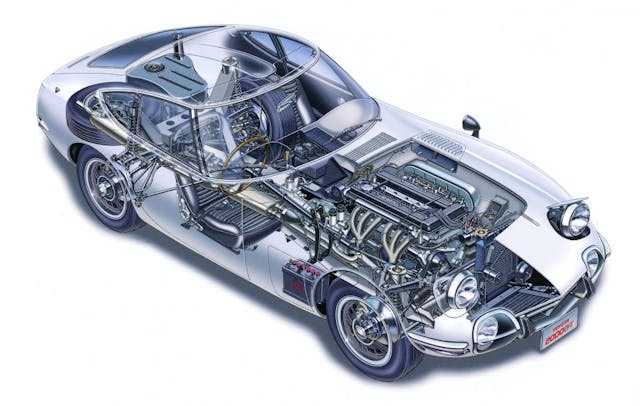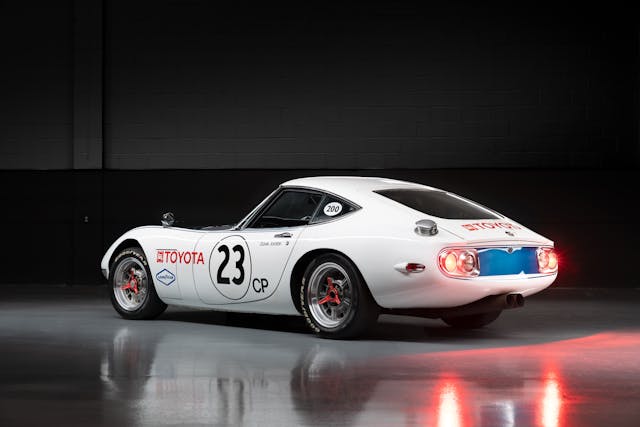A $2.5M sale is more than a record for the 2000GT. It’s Toyota’s revenge.
When the hammer fell on this 1967 Toyota 2000GT at the Gooding & Company auction at Amelia, it shattered two records. First, at a selling price of $2,535,000, it became the first Japanese car to break the $2M mark at auction; second, it established a new high-water mark as the most expensive Japanese car of all time. The sale rightly recognizes the 2000GT’s value as the first major Japanese effort to take on the sports car world and as the feat of design and engineering Toyota had hoped to create. What’s more, this exceptional vehicle, one of three touched by racing legend Carroll Shelby, comes with a backstory of betrayal and revenge.
Born just as Japan’s auto industry and car culture came of age, the 2000GT realized Toyota’s dream to create a true halo GT car. Enthusiasm for motorsport was on the rise in Japan—the first Japanese Grand Prix was held in 1963—and Toyota, far from the automotive giant it is today, decided it was time to compete on the world stage.
Toyota’s offerings in the early 1960s were anything but inspiring. Its first sports car, the tiny Sports 800 or “Yota-hachi,” appeared in 1965. A sprightly little thing with aluminum-intensive construction and one of the first production-car targa roofs, it made do with a paltry 44 hp. Even before the little Yota-hachi chugged into production, though, Toyota had loftier ambitions.

To that end, Toyota launched the 2000GT effort under the code Project 280A. With a crack team of five engineers, designers, and test drivers, it utilized several European cars as benchmarks. Although often regarded as a Japanese copy of the Jaguar E-Type given the design similarities, the 2000GT’s engineering was heavily influenced by another British sports car—the Lotus Elan 26R. From the 26R, chassis and suspension engineer Shinichi Yamazaki took the idea for a backbone chassis and fully independent suspension. But Project 280A couldn’t just be pretty and handle well, it also had to be quick.
Beneath designer Satoru Nozaki’s beautiful, flowing lines resided a rev-happy 2.0-liter six-cylinder engine. Toyota tapped Yamaha to create a double-overhead-cam head with excellent airflow characteristics. Redline was a lofty 7000 rpm, with just shy of 150 horsepower in road-going trim.

Everything came together for Toyota’s would-be world-beating GT. When it debuted at the 1965 Tokyo Motor Show, crowds flocked to see Japan’s entry into the modern sporting market. The 2000GT impressed with technology that kept pace with the best sports cars of the time, including a limited-slip differential, five-speed gearbox, and power disc brakes at all four corners. The car generated excitement while sitting at the motor show, but one question remained: how would it fare on track against the likes of Porsche?
Toyota immediately set about establishing the 2000GT’s performance credibility by setting a series of speed records with it. In 1966 at the newly-constructed Yatabe Circuit, a 3.5-mile oval with steep banking, an aluminum-bodied pre-production prototype 2000GT set thirteen separate FIA time and distance records over 72 hours. Impressively, the car performed this multi-day test at sustained speeds of 125 – 130 mph without mechanical fault.
That same year, a pair of unusual little cars took first and second in the Mission Bell 100 across the Pacific in Riverside, California. Prepared by an upstart new team called Brock Racing Enterprises (BRE), the two Japanese rear-engined Hino Contessas impressed the large crowd. Their one-two upset made headlines back in Japan, too, leading to some notoriety for Pete Brock, the young engineer behind the team. A former employee at Shelby American and designer of the Shelby Daytona Coupe, Brock was just beginning to make a name for himself.

Hino executives were delighted, but the 1960s were a time of sharks and minnows in the Japanese automotive industry. In an effort to make their nation’s car companies more competitive globally, the Japanese government pushed for larger automakers to absorb smaller ones. As fate would have it, Toyota purchased Hino for its Hilux small truck line and wound down Hino’s passenger car production, including the Contessa. This put Brock out of the Hino racing business, but his success hadn’t gone unnoticed at Toyota. There was a project for him in the 2000GT.
Toyota intended to take the 2000GT racing in America in the SCCA’s C-Production class, then dominated by Porsche’s 911. Considering that BRE had managed to take the virtually unknown Contessa to its maiden victory, Toyota offered Brock the contract to run its 2000GT effort.
In a parallel universe, it was a BRE-liveried 2000GT, perhaps with an SCCA trophy sitting in the passenger compartment, that set the sales record at Amelia last week. In this one, however, a last-minute sales pitch by Shelby —made in-person in Japan—was enough to convince Toyota to switch racing teams. After all, Shelby had just helped Ford beat Ferrari. Who better to help Toyota go to war with Porsche?

The jilt left a bad taste in Brock’s mouth. According to him, he first heard of Toyota’s change of heart was when three 2000GTs showed up at Shelby’s headquarters rather than his own shop. Stung by the end-run, he decided to leverage some of his old Hino connections into getting a couple of Datsun roadsters direct from Japan.
With these Datsuns, Brock hatched a plan. Whenever he heard that the Shelby teams were headed to a race out east in search of regional points, the BRE team would show up with their roadsters to hound the 2000GTs. The Datsuns ran in D-Production, a different class than the 2000GTs, but Brock’s roadsters were quick enough to get in the way of the Toyotas and spoil the racing line—while letting Toyota’s Porsche rivals past.

Further hampered by an SCCA ruling requiring the Toyotas to run Solex instead of Weber carburetors, the 2000GT couldn’t defeat its European competition. The team managed four outright wins but still finished fourth in the championship. Embarrassed by their flagship’s failure to achieve instant success, Toyota pulled the plug. Two years later and with their personal battle in the rearview mirror, the BRE team put a Datsun 240Z on the top of the C-Production podium, proving Japan’s international racing prowess.
Although Shelby didn’t get to slay another European motorsports giant, last week’s sale may have given him, as well as Toyota, the last laugh. Toyota’s design and Shelby’s imprint on the 2000GTs helped set the stage for competitive Japanese sports cars and racers for years to come. Now, the 2000GT has set the bar for a Japanese collector car market on the rise.


